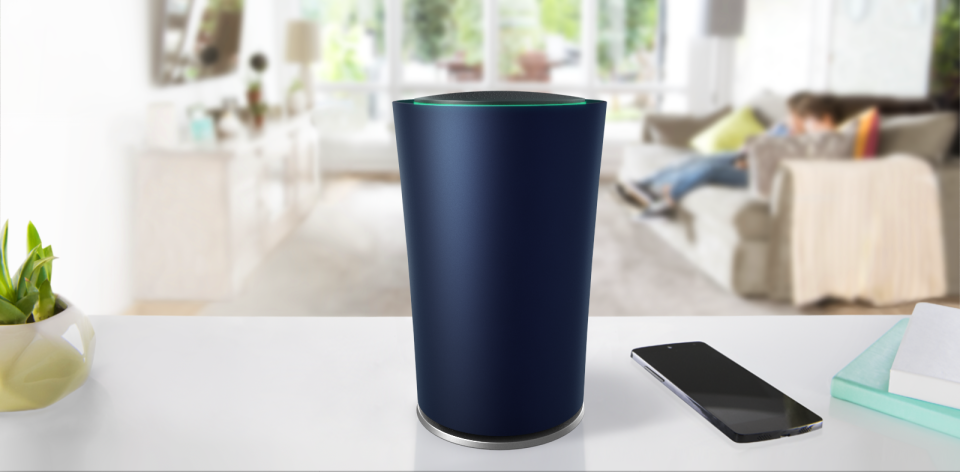Google’s stylish new Wi-Fi router is amazing — but not worth $199

The Google OnHub wireless router
Last week, Google came out of nowhere to announce the OnHub, a stylish new Wi-Fi router developed with partner TP-LINK. It promised to provide a better, easier way to connect to the Internet in your own home.
And the market responded: The Google OnHub sold out of pre-orders almost as soon as it went up on Google’s own Play Store and Amazon.
Today, the Google OnHub goes on sale to the general public.
After a few days testing an OnHub that Google loaned me, I can confirm that it’s a technical marvel that brings form and function together into something really cool and useful, which is a weird thing to say about a router.
The OnHub already saved me a ton of headaches in my San Francisco apartment, where thick walls and a weird layout had previously made getting online a real pain.
But at its $199.99 price point, it’s really hard to recommend. Especially when you can get a super-high-performance router from the likes of Asus for $108 from Amazon.
Take a look at what makes the Google OnHub so different — and where it falls short.
The OnHub’s stylish design is an important part of the product. Most people hide their routers behind the TV or on a bottom shelf — which is awful for radio reception, and hurts a lot of people’s Internet connection. If it looks cool, people won’t mind having it sit out in the open.

The problem with that idea, though, is that the router has to be physically connected to the modem, which is still an ugly slab of plastic. Unless you’re running a long ethernet cable, that means you’re limited to where the OnHub can actually sit. I ended up putting it in the rear of the TV after all.

Under the hood, the OnHub has an array of three antennae (the flat black things) that Google promises provides way better reception. In my own tests, the range of the OnHub was so good that I no longer needed a range extender to blanket the whole apartment.

The router has alerts to tell you if things are working right — it turns blue if everything’s connected, red means something’s broken. Kind of nifty: Google worked with the Nest team to make sure that all of the colors for alerts are the same across all of the search giant’s connected hardware.

Here’s the OnHub without the cylinder shell on, if you prefer that look.

And here’s the naked OnHub from behind. It has a power port, a USB slot (for completely recovering an OnHub that somehow gets damaged or corrupted), and only two ethernet ports: One to plug in from the modem, and one to plug a physical wire into whatever you’d like. As a gamer, a wire is the best way to ensure a stable, solid Internet connection — that means a tough choice if you have multiple game consoles. In the end, I plugged it into my TV to make sure Netflix would stream smoothly.

The best part of the Google OnHub is the app you use to control it, which is available for Android and Apple’s iOS. You log in with your Google account, which registers the OnHub to you. From there, it quickly sets it up. I had a minor error during setup, but on a second try, it worked flawlessly. The only thing you have to do is name your network and give it a password. It’s a lot easier than a lot of other router setup tools.

The OnHub’s speaker plays a sound. The phone listens for it, then pairs up with the router. Even though OnHub has a speaker, it doesn’t have a microphone, which means it’ll never get the Google Now virtual assistant (and it won’t ever be like the Amazon Echo). At least not in version 1.

But Google promises that the OnHub will get smarter over time, with new updates, features, and security patches.

So what’s the app for? First, it gives you a really clear view into how much Internet bandwidth is being used by whom. I was able to tell when my roommate was watching Netflix because his usage spiked up. And, yes, you can access an OnHub remotely — good news if you have to provide tech support for parents and grandparents.

It also provides an incredibly useful speed testing tool that provides context for your results. Better yet, it includes the “WiFi Efficiency Score,” which shows how much of the signal is actually getting through to your phone. By taking the app around the apartment and running it, I could figure out where the dead spots were.

It also has a feature to quickly show and share (via text message, Facebook Messenger, email, or otherwise) your WiFi password. Google says that while it’s not exactly the most secure way to share a password, it’s basically how people were doing it already. So why not simplify?

Finally, the OnHub app lets you set a “priority” device that throws it to the front of the line when it comes to grabbing Internet bandwidth. In my limited testing, it didn’t seem to make much of a difference, but it’s a cool idea, especially if you’re doing stuff like hosting a Netflix binge-watching party.

In conclusion, the Google OnHub is a really cool idea that did a lot of good in my apartment. But for $199.99, with only one wired ethernet port, and no ability (yet) to use it as a digital assistant, a hub for connected devices, or even a Bluetooth speaker, it’s hard to recommend. It’s just a really expensive router.

The post Google’s stylish new Wi-Fi router is amazing — but not worth $199 appeared first on Business Insider.

 Yahoo Finance
Yahoo Finance 
